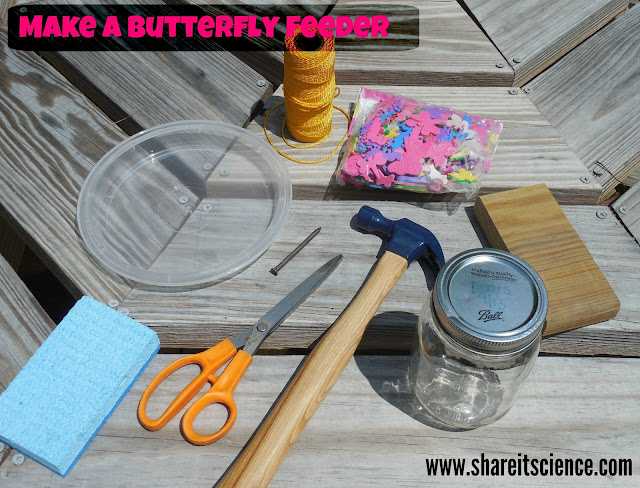Pollinator Week happens each June! What better time to investigate one of my favorite plant pollinators? Butterflies!
I decided to build some butterfly feeders to see if I could attract even
more butterflies to my yard this year. This will be an experiment that
will last all summer long. I want to know where butterflies spend the
most time in my yard and what type of butterflies visit. You can try it
too!
This post contains affiliate links, meaning I may receive a small commission if you purchase something from one of these links, at no additional cost to you. Please see disclosures for more information.

Build your own butterfly feeder
First I made two different types of butterfly feeders. One is a jar feeder, and the other is a plate feeder. Both used either recycled materials, or things I found around the house. I used the following materials:
To make the jar feeder:
1. Punch a hole in the lid with the hammer and nail.
2. Cut a strip of sponge and poke it through the hole in the lid. You may need to use the nail, or a pair of tweezers to get it through.
3. Decorating your jar with bright flower colors or faux flowers can help attract your butterflies. I used some bright foam insect stickers.
4. Tie some string on the jar to create a hanger. Remember that your jar will hang upside down, with the sponge sticking out the bottom. I added a little duct tape to secure the string, just in case!
5. Make the sugar solution. Mix 4 parts warm water, 1 part sugar to dissolve.
6. Fill your jar, flip it over and hang it up!
The plate feeder was even easier to make.
1. Poke holes for the string with the hammer and nail. If you have a scrap block of wood to hammer the nail into, it helps prevent the plastic from cracking.
2. Make a hanger with some string.
3. You may want to find something with a little weight, like a rock to place in the middle of the plate to keep it from blowing too much in the wind.
4. Fill your plate with bright fruit. Slices of banana that have been in the freezer, and orange slices are good choices. I varied what was on my feeder based on what I had in the house that day. You can add some orange juice or sugar solution to help keep the fruit from drying out.
**Watch your fruit and replace it if it begins to get dried out or moldy. Also keep in mind that any type of feeder can attract unexpected and possibly unwanted animals to your yard. For example, if you are in an area with black bears, it's
not a good idea to leave your feeder out over night.**
Observe Butterflies
Now you have two feeders to observe, and any plant that butterflies enjoy visiting in your yard! You can now begin your experiment. Find out which plant or feeder the butterflies in your yard prefer. Begin making observations. You can use this
printable observation sheet to keep yourself organized.
Any time you put a new feeder in your yard, it takes time for the animal you are hoping for to establish itself. When I hung my feeders the Eastern Tiger Swallowtail butterflies that are plentiful in our yard were very busy slurping nectar from the late-blooming lilac bush nearby. I coaxed them to the feeder with some lilacs. They are still more interested in these flowers than the feeder. I wonder what will happen once the lilacs are finished blooming? The only way to find out is to keep making good observations!
You will no doubt observe other visitors to your feeders as well. Within a few days, I noticed a pair of Evening Grosbeaks swoop down and check out the feeders, quickly moving on once they realized there were no seeds to be had. I've also spotted ants attracted to the fruit.
Once you've found your butterflies to observe, you'll want to identify them! There are so many different types of insects, and so many different butterflies! Where do you start?
Check out Growing with Science's excellent guide
"Butterfly Identification for Beginners" to get you started.
Excited to do more science this summer? This is just one post in the Spectacular Summer Science Series!
Want to learn more about pollinators? Check out these posts:




































